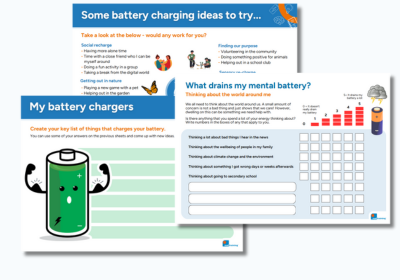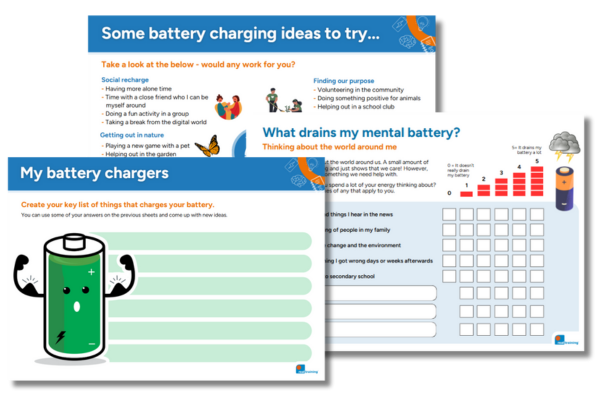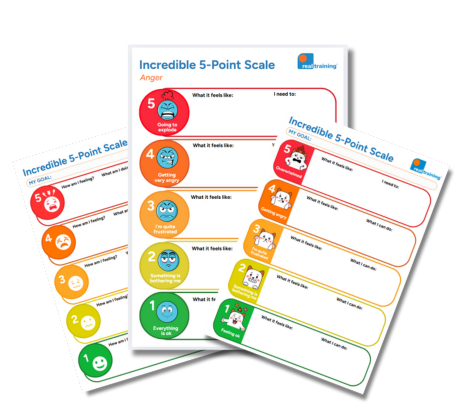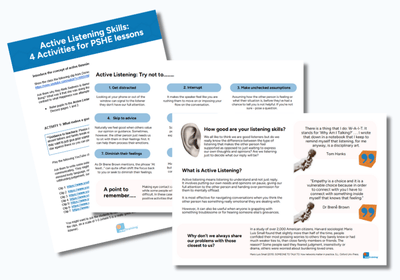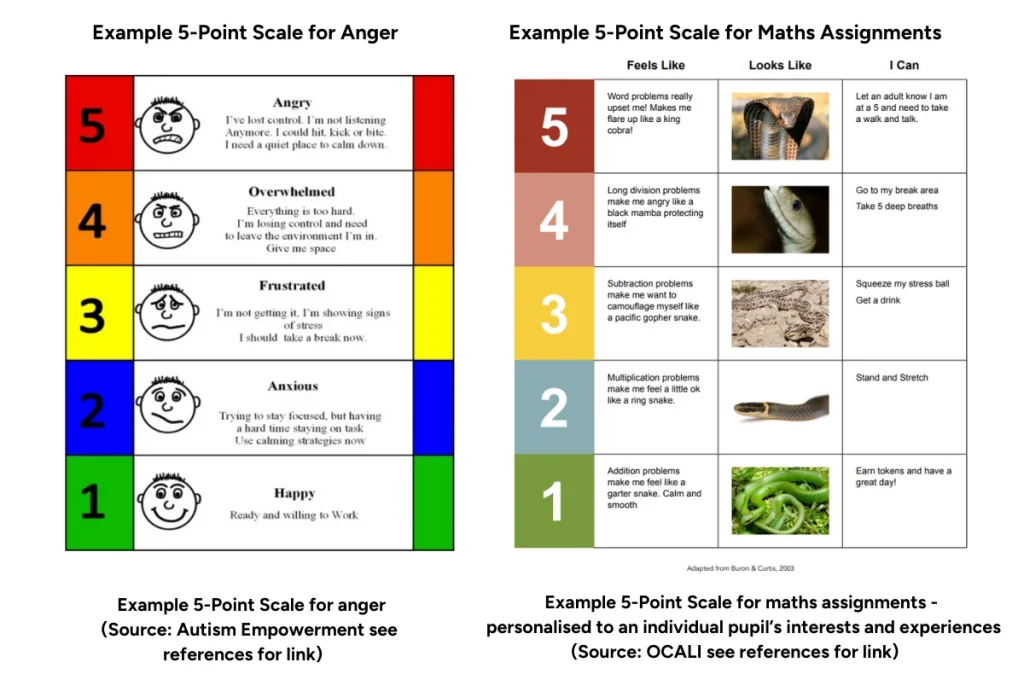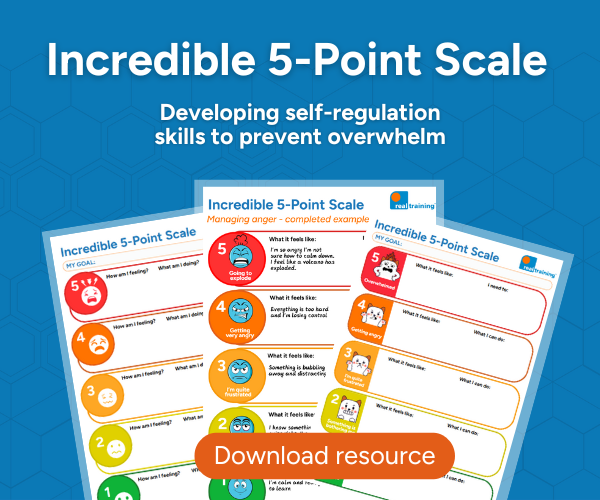These mental health resources are designed to introduce children to the concept of their personal emotional battery and encourage them to reflect on what drains and recharges it. The aim is to help build resilience and a set of personal strategies to help them plan ahead and manage day-to-day stressors.
Charging My Mental Battery:
KS2 Primary Resource
We all have things in our lives that absorb a lot of our mental energy. Our brains need recharging sometimes – just like a battery does.
This resource looks at some of the things most likely to be impacting children in Year 5 and 6, helping them build self-awareness and develop personal recharging strategies to improve their mental wellbeing.
Includes: Worksheets, activities and a battery-charging weekly planner.
Charging My Mental Battery:
Resource for Teens
This resource helps teens build awareness of things that drain their emotional, social, cognitive and sensory battery.
It provides tips for managing stress as well as encouraging teens to think about different strategies to restore their mental and emotional energy. It also includes a basic energy accounting tracker which neurodiverse students might find especially helpful.
Includes: Teacher guidance notes, worksheets, battery charging weekly planner and energy accounting tracker.
After beginning her career as a Graphic Designer, Amna transitioned to supporting students with diverse learning needs at a British school in Dubai and is now the Inclusion Lead at an IB school in Pakistan and SENCO for students in Middle Years and Diploma programmes.
Committed to professional development, Amna says she “embraces the belief that education is a lifelong process,” something she passionately believes is “particularly crucial in the field of inclusive and special education.”
How has the course helped make an impact at school?
Initially unable to pursue an on-campus MEd, I chose Real Training for its online flexibility and tailored module selection. This allowed me to focus on areas like iSENCO, aligning perfectly with my interest in inclusive education.
What made you choose the Real Training course over other options?
The iSENCO course has directly improved the learning outcomes of students in my setting by enabling more effective and inclusive educational practices.
I have successfully enhanced and refined SEND policies leading to noticeable academic and social performance improvements and a forthcoming data management system is poised to better track and support individual student needs. The course has also empowered me to implement targeted interventions that have already shown remarkable results.
The assignment comparing SEND policies and settings between two schools turned out to be particularly impactful. By examining different approaches, I identified key areas for improvement and implemented strategies that fostered a more inclusive environment. This task encouraged a critical evaluation of existing policies and inspired innovative thinking in tailoring our approaches to meet diverse learner needs effectively.
I’ve also improved the strategic use and budgeting of SEN resources and I’ve enhanced the professional development of Learning Support Assistants (LSAs) through targeted training and coaching.
How has the course helped you develop professionally?
Participating in leadership and SEN-related workshops has prioritised my personal and professional growth, enhancing my ability to lead and advocate for effective SEND provisions. Moreover, I’ve increased interactions and collaborations with parents and external partners, strengthening the support network for our students and fostering a cohesive community focused on inclusive education.
Overall, the iSENCO course has been invaluable in equipping me with the tools to enhance SEND provision in my professional setting, benefiting the learners we aim to support. I would highly recommend it to other SENCOs based abroad.
What did you enjoy the most about the course?
I enjoyed the practical application of the concepts learned, particularly the assignments that allowed me to directly improve my school’s SEND policies and practices. The opportunity to engage deeply with specific issues, such as comparing SEND policies between schools and implementing a data management system, was especially rewarding. These tasks enhanced my professional skills and had a tangible impact on my educational setting, making them the most enjoyable and fulfilling aspects of the course.
What are the top three things you have implemented since or during your study?
- Expanding on the success of my case study intervention I’ll be planning further personalised learning strategies to meet diverse student needs.
- Establishing a robust data system will enable more precise tracking of individual student progress and the effectiveness of different interventions.
- Organising and possibly leading training sessions for staff on the latest SEND strategies and interventions can also improve the overall effectiveness of my school’s SEND provision.
Neurodiversity Week 2025 is just around the corner….
Neurodiversity Celebration Week was started by Siena Castellon, an autistic teenager who also has ADHD, dyslexia, and dyspraxia. This year (March 17th- 23rd) will be the seventh annual Neurodiversity Celebration Week since it began in 2018!
Siena started the awareness week with the aim of challenging stereotypes and misconceptions about neurological differences, promote inclusive environments and recognise the many talents of neurodivergent individuals.
To celebrate, we’ve produced some Neurodiversity Celebration Week colouring posters which are great for young people of a variety of ages and can be used as part of wall displays or mindfulness clubs.
8 Ideas for Celebrating Neurodiversity Week in Primary and Secondary Schools
- Student entrepreneur fair or rainbow cupcake sale – host a lunchtime event and raise money for a charity championing neurodiversity.
- Facts and myths board – divide a display board into a ‘facts’ and ‘myth’ section about ADHD, autism, dyslexia, dyspraxia, dyscalculia, Tourette’s (or any other form of neurodivergence) and ask pupils to pin statements on either side to create a display.
- Build your own character strengths profile – VIA Institute on Character is a non-profit organisation offering a free online tool that allows students to uncover their strengths. Students could use the report generated to make a poster illustrating their attributes and also think about what helps them to learn. Suitable for ages 8 – 17 https://www.viacharacter.org
- Neurodivergent guest speakers – invite people in the local community to host a workshop or present an assembly.
- Video messages of support – suggest to your neurodivergent pupil alumni that they might like to send in video or voice messages of support to current students. Current neurodivergent older students (or school staff) may also like to send in their messages for younger pupils.
- Dress in rainbow colours, wear something sparkly or wear footwear of their choice to represent how we all think differently and all minds deserve to shine.
- Book club – choose a class book to read that has a neurodivergent main character e.g. Percy Jackson and The Lightning Thief.
- Origami umbrellas – students can follow the video below to create their own. You could ask them to also write down one stereotype about neurodiversity to avoid making. Create a wall display with the results. Watch the video here. https://www.youtube.com/watch?v=Hp9Zn89xG_Y
Don’t forget to take a look at the fantastic resources on the Neurodiversity Celebration Week website.
What are the most commonly used symbols for neurodiversity?
- The infinity symbol represents the infinite variations of neurocognitive functioning. The rainbow colours signify the diversity of the neurodivergent community.
- Umbrellas represent the fact that “neurodiversity” is an umbrella term for a wide range of neurological differences.
You may see a puzzle piece symbol being displayed – particularly to represent autism. However, many autistic people prefer this not to be used as it implies people are a problem to be fixed.
What are the most commonly used symbols for neurodivergent differences?
- Autism – a rainbow infinity symbol, ribbon or colour blue
- ADHD – a butterfly
- Dyslexia – the letters “p” “q” “b” and “d” together
- Dyspraxia, Tourette’s, DLD, dyscalculia and other conditions – don’t have officially recognised symbols, but the sunflower motif represents hidden disabilities and a rainbow infinity symbol is often used. Some people also use teal ribbons.
Introducing: Practitioner of The Dyslexia Guild – Assessor of Access Arrangements
We’ve been working alongside our sister company, The Dyslexia Guild, to create a new membership grade for Certificate of Psychometric Testing, Assessment and Access Arrangements (CPT3A) graduates.
Recently launched, the Practitioner of The Dyslexia Guild Assessor of Access Arrangements (PDG3A) membership, provides a number of professional benefits to those who have studied our CPT3A qualification. By choosing to become a member, you’ll be able to:
- Gain formal recognition for your expertise in access arrangements assessment
- Connect with a network of like-minded professionals dedicated to supporting individuals with dyslexia or literacy-related difficulties and those that require access arrangements
- Borrow selected assessment tests for free through our library*
- Participate in a variety of opportunities for professional development
- Save up to 10% off most products purchased through the Dyslexia Action Shop
- Enhance your professional standing and demonstrate your commitment to best practices.
*terms may apply
Eligibility
To be eligible for this grade of membership, you must hold the Certificate in Psychometric Testing, Assessment and Access Arrangements (CPT3A) from Real Training (similar courses will not be recognised).
Please note: this grade is not applicable for those who already hold Guild membership at Member (MDG), Fellow (FDG) level or those who already have an Assessment Practising Certificate (APC).
Feedback from our delegates is very important to us. This is why we ask every delegate to fill out a feedback form upon completion of their course. This provides us with extremely valuable data on what we’re doing right, and where we can improve.
We’ve been carefully analysing the data from 2024, and below are highlights from the results.
- 93% of delegates rated our course as ‘good’ or ‘very good’.
- 94% of delegates rated the extent to which their course met their developmental priorities as ‘good’ or ‘very good’.
- 94% of delegates rated the course tutor feedback, support and interaction as ‘good’ or very ‘good’.
Comments from our delegates!
“I have found the feedback extremely informative and it has helped to develop my academic writing. My tutor was quick to respond to emails and answer any questions I had”
- Samantha Hutton, Autism Spectrum Conditions delegate, 2024
“The in-person work was inspirational. It was really clear and useful. Feedback on all aspects of the course throughout the online section has been really constructive”
- Mark Westwood, CCET Intensive delegate, 2024
“I felt well supported, any queries were answered straight away and I always felt like I was talking to a real, knowledgeable person rather than getting a standard response”
- Victoria Rogers, Dyslexia Professional Report Writing delegate, 2024
“My tutor was always responding to my questions and provided excellent feedback on the improvement of my essays”
- Panagiota-Maria Pantoulia, International Award for SEN Coordination delegate, 2024
“The tutoring I received was excellent, really useful suggestions and advice and any questions that I asked were responded to promptly”
- Jo Platt, Senior Mental Health Leadership Certificate delegate, 2024
If you are thinking of enrolling on a course with us, either for the first time or are a returning delegate, please don’t hesitate to get in touch with us on +44 (0)1273 35 80 80 or contact us here.
We all like to think of ourselves as good listeners. Especially those of us who work in education. But the ability to listen actively is a distinct skill that’s not as intuitive as it first appears.
When we hear about a problem or challenging situation being articulated by a colleague or young person, our instinctive response is to try to analyse that problem and help them fix it. But in some contexts, this natural desire to problem solve and to make the person feel better as soon as possible, needs to be put on ice.
We have to slow down and just be in the moment with the young person, absorbing and sitting with their emotions, rather than seeking to distract from them.
Suppressing the desire to broadcast
To paraphrase Stephen Covey, active listening is the difference between “listening to understand” and “listening to reply”. A difficult skill for any adult to master perhaps, but potentially even more so for children. This is the first generation to grow up inside a highly addictive digital world – where people are in constant ‘broadcast mode.’ Just think of the content creators and TikTok gurus with a constant flow of 30-second soundbites of advice, opinion and quick-fixes.
And yet active listening skills are essential for all of us (teachers, parents, students, employees, managers) to become more empathetic and more productive – so where should we start?
Active listening: 7 principles
Practising good active listening involves suppressing our ego and shifting the locus of communication to the other person – giving them permission to offload (usually on an emotive topic). In doing so we become aware and responsive towards their feelings – something psychologists refer to as “attunement.”
It can be helpful to break it down into the following principles:
- Paying attention – using non-verbal and verbal cues; such as turning your body and head, and maintaining good eye contact (exceptions being when the other person finds this threatening or culturally inappropriate).
- Encouraging – nodding, smiling (or frowning in empathy as appropriate) as well as short interjections.
- Eliciting – asking open-ended questions to draw more from the speaker. This can sometimes mean just waiting in silence, allowing the other person time to process their thoughts and emotions. ”What else?”
- Reflecting and Clarifying – making inferences and checking they are correct, helps to show the person that we care as well as helping us get on the same page. Mirroring some of their language can also help with attunement. “This situation is clearly leaving you drained, as you say – and it’s having an impact at home too – am I right?” Or “Help me understand…is it that…?” “It seems the crux of the issue is….”
- Validating – acknowledging the gravity of the situation and accepting the person’s emotional response. “It sounds like this past week has been very hard for you – that must be really tough” or “I’m so glad you spoke to me because this is really important.”
- Summarising – using all that we’ve learned from the speaker so far to paraphrase what they have said. “So you’re really missing Adam since he moved to France, he was your best friend and a good listener and it’s taken you longer than you thought to realise how important he was and now you feel really sad that he’s not around to talk to after school.”
- Guiding – giving advice (if there is any to be given) should always come at the end of the process and if possible be focused on inspiring the other person to investigate solutions. ”Some people find it helpful to try X or Y.” If it’s a work problem a colleague is raising you don’t always have to agree with them but you do need to convey to them that you’re taking what they’ve said on board.
Some things to avoid
Sometimes it’s also useful to understand what can derail active listening.
- Assuming you know what it feels like; before really giving the other person the opportunity to tell you. If a colleague is having anxiety adjusting to a step up, cutting straight in with “I remember when I joined the senior leadership team – it was a big leap but I just kept ploughing on and eventually things settled down” fails to acknowledge the immediacy of their feelings and can emphasise the distance between you.
- Interrupting; although sometimes useful, it takes a very skilled listener to know when and how to do this. Better to sit tight and wait.
- Shifting the emphasis back onto you; can be damaging even with the best of intentions. Take a family break-up, for example. An adult responding; “My Dad walked out on me too, when I was younger than you”, often means the young person will hear; “This happened to me. In fact it was worse for me, but I dealt with it and so should you.” In other scenarios our own feelings of insecurity creep out “at least you know what the problem is with your project – I don’t even know how to get started….” or “you’re going to do great – it took me years to learn how to get through OFSTED without being nervous.”
- Being fearful of silence; one of the most surprisingly difficult parts of active listening but some of the best introspection can come from letting it linger. It’s difficult to judge the best cadence admittedly.
Encouraging active listening skills in children
Like many social skills, active listening can be understood on different levels. While primary school PSHE lessons may focus more on basic behaviour, making eye contact, thinking about what has been said before you respond, not getting distracted etc. it’s only once children become older that they can more fully grasp the seven principles mentioned above.
There are two important points to consider before attempting to teach or develop these skills in others. Firstly, it’s really important that young people are able to understand the full value and purpose behind active listening and so want to engage with it. Secondly, we need to check-in with the other adults around them – are we modelling it often – and correctly?
There are many contexts in which learners can start to practice their skills, before they dive headfirst into more emotionally heavyweight conversations; in English and PSHE lessons and in smaller groups such as on student councils and during form time, for example. Active listening skills can also form an essential part of restorative justice systems where both parties listen to one another’s grievances. In all instances, pupils should be recognised and praised when they make an effort and/or do it well.
[We’ve pulled together a few ideas for active listening activities aimed at teenagers that you can download here.]

Helping children in distress
If a child is finding something difficult then teachers may well find themselves at the first point of call and sometimes can help right away. However, when a young person is in distress the situation changes. There may be safeguarding concerns, you may need to refer to your designated safeguarding lead or SMHL.
The role of ELSAs
One great way that schools can provide small group or one-to-one support to help children experiencing anxiety, bereavement, anger or other social/emotional needs is by using ELSAs (Emotional Literacy Support Assistants).
ELSAs, often teaching assistants, receive training in active listening (and basic counselling techniques) from educational psychologists and participate in regular supervision. It allows them to form personal connections with children they are working with who often need more time and space to process their emotions. Schools that have started ELSA programmes frequently report many positive benefits including improved attendance, positive feedback from teachers and parents and of course significant improvement in self-reported well-being from pupils themselves.
You can now train to be an ELSA as part of the recently launched Level 5 Specialist Teaching Assistant apprenticeship which is fully funded through the Government’s apprenticeship levy.
Sound draining? You’re probably doing it right.
Anyone can get started with active listening but it may not feel natural at first. Counsellors and EPs spend years honing their skills to be able to practice at a more nuanced level with more complex conversations.
Observe others who do this well in your school. It might be someone on your senior leadership team, a fellow teacher or a dinner lady. Some older children are surprisingly good at it. If you line manage others or interact with parents of vulnerable children, think about these interactions too.
The effort we put in pays dividends. Some level of active listening (however basic) is a valuable skill for us all. It can help us to function better in our family unit, as part of a more inclusive school, and in a more productive workplace.
Find out more: Courses
Explore the Level 5 Specialist Teaching Assistant apprenticeship with ELSA qualification
Find out how to become a better coach or mentor in a school environment in our Coaching and Mentoring in Education course.
Further active listening resources
Active Listening for Teens: Take a look at our ideas for PSHE activities here
Harvard Business Review: A great video about active listening in a line-management context: www.youtube.com/watch?v=aDMtx5ivKK0
Brené Brown on Empathy: A powerful video that neatly explains the difference between listening with empathy and listening with sympathy: youtube.com/watch?v=1Evwgu369Jw&vl=en-GB
Education Support: Jacob Morgan, author and Founder of Founder of FutureOfWorkUniversity.com introduces the BUILD acronym: jacobm.medium.com/5-ways-to-practice-active-listening-924b58746494
Know Yourself, Grow Yourself!
This year marks the 11th anniversary of Children’s Mental Health Week – a campaign led by mental health charity, Place2Be. This year’s theme is Know Yourself, Grow Yourself and is focused around the theme of self-awareness and building resilience.
The need to support our young people is pressing; according to an analysis from The Children’s Society, 15-year-olds in the UK report the lowest life satisfaction scores of all the countries across Europe. [1] Helping children face the pressures of modern life means working on personal resilience, as well as encouraging good listening skills.
We’ve put together a range of resources to help pupils become more self-aware and develop personal strategies to nurture their own wellbeing, or to support emotional regulation.
Charging My Mental Battery:
KS2 Primary Resource
We all have things in our lives that absorb a lot of our mental energy. Our brains need recharging sometimes – just like a battery does.
This resource looks at some of the things most likely to be impacting children in Year 5 and 6, helping them build self-awareness and develop personal recharging strategies to improve their mental wellbeing.
Includes: Worksheets, activities and a battery-charging weekly planner.
Charging My Mental Battery:
PSHE/Group Work for Teens
This resource helps teens build awareness of things that drain their emotional, social, cognitive and sensory battery.
It provides tips for managing stress as well as encouraging teens to think about different strategies to restore their mental and emotional energy. It also includes a basic energy accounting tracker which neurodiverse students might find especially helpful.
Includes: Teacher guidance notes, worksheets, battery charging weekly planner and energy accounting tracker.
Incredible-5-Point Scale
The Incredible 5-Point Scale was originally developed by Kari Dunn Buron and Mitzi Curtis to help autistic pupils with self-regulation.
It can, however, be used to support any pupil who is particularly struggling with emotional self-regulation.
Includes: Guidance notes and downloadable pdf examples, including scales for anger and social anxiety.
Active Listening For Teens
We’d all like to think we are good listeners but how often do we listen to reply rather than listening with genuine empathy?
This resource breaks down the skill of active listening and explains some of the key things that good listeners tend to do (and what they avoid!).
Includes: Active listening worksheet for teens as well as four activity ideas for PSHE lessons. Take a look at our accompanying blog.
Other Children’s Mental Health Week Resources
Teachwire are showcasing a range of great free resources on their dedicated round-up page.
Visit the Place2Be website to download free assembly guides, activities and top tips for primary and secondary schools. This year they have partnered with Disney to bring you resources using Inside Out characters!
The National Literacy Trust has some great resources for children’s mental health week based around Charlie Mackesy’s book The Boy, the Mole, the Fox and the Horse, including an assembly, lesson plan and KS1/P2-3 and KS2/P4-P7 activities
Info 7 have a great selection of free films that deal with the topic of mental health that are free to stream in your classroom. They are also offering resources including short videos and lesson plans that cover everything from anxiety and bereavement to social exclusion and mindfulness for a broad age range.
Premier League Stars are offering this Building Self-Esteem resource which helps pupils think about their identity and how it relates to self-esteem.
1) The Children’s Society Good Childhood Report 2024. https://www.childrenssociety.org.uk/sites/default/files/2024-08/Good%20Childhood%20Report-Main-Report.pdf
The Incredible 5-Point Scale is a great visual tool that can be used to help children identify, understand, express and manage their emotions.
It’s particularly (although not exclusively) useful for supporting autistic children. However, it’s also a resource that is sometimes misunderstood in schools. We’re going to take a look at the best way to leverage the tool and how you can create personalised versions of it.
How was the Incredible 5-Point Scale developed?
The scale was created in 2003 by Kari Dunn Buron and Mitzi Curtis, highly experienced teachers from Minnesota who have many years of experience teaching autistic students. It was designed so that each level represents a different level of intensity surrounding a specific emotion and its associated behaviour/s. Together with helping to recognise emotions and planning how to respond and self-regulate (or seek help), the tool can also be used to explore ‘what happened’ after a problem incident.
It can be used for almost any kind of emotional regulation such as anger management, learning about social interactions (such as respecting physical space or dealing with winning and losing) or even particular behaviours such as modulating tone of voice.
Autistic children and adults often have a strong preference for using systems, but may struggle with the vocabulary for emotional introspection. Talking in numbers and colours instead of describing or naming an emotional state can help make this activity easier for some people.
The broad benefits of the scale include its:
- application to any age group
- ability to create a shared language to easily discuss emotions or behaviour
- avoidance of language that could be seen as blaming
- capacity to quickly communicate needs and generate self-awareness in the moment
- flexibility and the fact that it can be easily personalised to the individual
How to use the scale and create personalised 5-Point Scales
- Identify the behaviour that you would like to work on. The child should be involved as much as possible; this will depend on their age and communication capability. A starting point would probably be asking questions such as, ‘What is happening that we would like to stop happening?’ or ‘What is not happening that we would like to be happening?’. This will probably be a behaviour that is underpinned by an emotion / several emotions (e.g., walking out of class, calling out answers or not speaking in school).
- Identify the skill or understanding of concepts that needs to be learnt in order for the thing to happen/stop happening (e.g., tolerance to ‘wait’, impulse control or ability to manage fear).
- Break the intensity of feeling into five parts. For example, let’s say the skill you were trying to develop is managing anxiety while interacting with other children. You sit down with your pupil, Joe, and talk about how he is feeling at each level and how this relates to his behaviour.
- For Joe, this might look something like the following;
- Level 1: How am I feeling and what is happening? I am feeling happy and relaxed. I am talking with others, playing games and joining in easily.
- Level 2: How am I feeling and what is happening? I am feeling a little bit nervous, but I can still manage. I might need to ask for a little extra help or take a short break.
- Level 3: How am I feeling and what is happening? I’m starting to feel anxious. My tummy might hurt, and I might avoid talking or doing things I usually enjoy. I need to tell an adult or one of my close friends how I am feeling.
- Level 4: How am I feeling and what is happening? I feel really anxious and I am not sure what to do to make myself feel better. I need to ask an adult for help.
- Level 5: How am I feeling and what is happening? I can’t manage at all. I don’t feel like I can use my words. I need to wave or grab an adult to come and help me.
- Level 1: How am I feeling and what is happening? I am feeling happy and relaxed. I am talking with others, playing games and joining in easily.
- Create a visual scale. Talk with Joe about the levels (1-5) and develop a descriptor for each. The different levels will then be assigned different colours. Sometimes a picture can also be used to depict what each level ‘looks like’ for them. If a young person has a particular affinity with characters or animals (Disney, Mario World, Harry Potter, cats etc. you could consider using these).
- Discuss strategies to help manage the feeling when thinking about what each level looks like, together with describing the feeling, ask the child to suggest what they ‘might’ do [i.e., a behaviour] to help. Returning to our example, for Joe this might look like Level 3: I need to tell an adult or one of my close friends how I am feeling.
- Teach the scale. A story might be a good way to explain to the child what each level means and how it feels. Real-life examples can also be used to illustrate each level.
- Use the scale – and review it. Encourage the pupil to use the scale to monitor their own emotions and behaviours. A ‘check-in’ at the start and the end of the day can help with this. The pupil might rate themselves according to where they were on the scale at different times of the day. This information could be used to jointly identify triggers or warning signs – and how to manage and/or avoid these.
[Take a look at our free downloadable examples for social anxiety and anger, as well as generic scales – remember templates are just a starting point]
IDEA: You might want to create a smaller portable version that the pupil can carry around in their school bag and refer to more discretely. Once the young person knows the scale well, they may just need a slimmed-down ‘prompt’ version. Take a look at this example that’s designed to fit on a keyring (below) from Cheshire East Council.
Things to try to avoid when using the scale
1. Taking a top-down approach
- Avoid: Adults taking it upon themselves to create the scale and then discussing it with the pupil, rather than listening to their specific experiences and tailoring it to their individual needs, emotions, and triggers. A template and/or some examples can be a good starting point, but the end output should be personalised.
- Why it matters: The scale works best when it is used to generate self-awareness – the only way to do this is if it is produced collaboratively. All levels should reflect emotions or behaviours specific and meaningful to the individual.
2. Using it with children who aren’t yet able to reflect and regulate
- Avoid: Forcing children outside of their comfort zone, by trying to teach the scale when they can’t yet grasp the necessary skills to use it well.
- Why it matters: Children need to be able to not only recognise their own emotions (with some support), but also engage in self-regulation afterwards. If you find yourself intervening too much it may be because the child is too young or doesn’t yet have the vocabulary to engage.
3. Using the tool for behaviour modification
- Avoid: Using the scale as a punishment/behaviour modification tool or linking it too closely to school rules.
- Why it matters: This risks shaming the individual, and increasing anxiety or disengagement, reducing its effectiveness by removing agency and trust. Instead, talk about possible natural consequences of specific actions if required.
4. Not using it consistently
- Avoid: Inconsistent use amongst key adults around the child including other support professionals, teachers, TAs, and (in some contexts parents as well).
- Why it matters: Having different systems to name and label behaviour is going to get confusing very quickly. Having some consistent routines to help self-regulation helps build positive habits.
5. Overwhelming complexity
- Avoid: Adding too much detail/ too many levels.
- Why it matters: The strength of the Incredible 5-Point Scale lies in its simplicity. Overloading the scale can cause confusion.
6. Not linking to coping strategies in line with emotional regulation development
- Avoid: Missing out actionable strategies for each level.
- Why it matters: The scale should gradually be used to guide children toward coping mechanisms – some of which might involve asking for help. Pupils should be encouraged to recognise when they are at Level 2 or 3 in particular, as this is where they might have most success bringing things back under their control.
7. Not reviewing the scale appropriately
- Avoid: Treating the scale as static and unchanging.
- Why it matters: Children are developing all the time and so are their needs as well as their coping strategies. It may be that the individual no longer needs the scale for a particular behaviour or that they need greater support if other stressful things are going on in their lives or their normal coping mechanisms are exhausted. Sometimes things about the school routine, peer dynamics or available support changes and their Incredible 5-Point Scale needs adjusting to reflect this.
Further reading
Read the original book from Kari Buron and Mitzi Curtis:
Buron, K.D., & Curtis, M. (2003). The incredible 5‐point scale: Assisting students with autism spectrum disorders in understanding social interactions and controlling their emotions responses. Shawnee Mission, KS: Autism Asperger Publishing Company.
Kari Dunn Buron’s accompanying blog has some great downloads and her blog covers extended applications www.5pointscale.com/
Autism Classroom Resources have written up a useful introduction to the scale: autismclassroomresources.com/the-incredible-5-point-scale-review-and/
Southwark Council’s autism support team have produced a helpful overview including quite a few examples for anger/volume etc: localoffer.southwark.gov.uk/assets/attach/677/5-Point-Scale.pdf
Example 5 Point Scale for Maths assignments: from OCALI (Ohio Centre for Autism and Low Incidence) Take a look at several examples of what you can do with a scale by relating it to an individual’s special interests, as well as a video about how practitioners are using the scale.
The Incredible 5-Point Scale Fact Sheet from Autism Empowerment – useful resource that also describes the anxiety curve model: Download the factsheet.
Autism Toolbox: Example of a scale completed for a particular individual pupil:
autismtoolbox.co.uk/wp-content/uploads/2022/09/5-point-scale-example.pdf
“I talk to people a lot better because in the first lesson, I didn’t talk at all. I talked to Miss … I whispered in Miss’s ear if I wanted to say something … but last time I did it, which was yesterday. I just … I was speaking.” – Alois (quoted in Purcell, Kelly & Woods, 2023)
The quote above is from Alois, a secondary school pupil reflecting on how time spent with his ELSA (Emotional Literacy Support Assistant) helped build his confidence in class.
Although there is limited large-scale research on the effectiveness of ELSAs, there are smaller studies, such as the one quoted above, that suggest they can be highly effective across all age groups. Headteachers and class teachers often report reductions in absenteeism, as well as increased confidence and engagement in learning amongst children on the programme.
Here are some key steps to maximise the impact of ELSAs at different stages of your implementation journey.
What are ELSAs and how do they help children with SEMH needs?
The ELSA programme is run by Educational Psychologists and involves training school staff (usually teaching assistants) in theoretical psychology, active listening and practical activities. The programme is based on the principle that teaching emotional literacy – i.e. the ability to recognise and manage emotion in themselves and others, helps children to thrive.
ELSAs support children who are:
- anxious
- have low self-esteem
- have problems managing anger and frustration
- have difficulties making friends (are being bullied or doing the bullying)
- engaged in conflict at school (with adults or peers)
- suffering from bereavement or trauma.
Dr Joanna Wood is a lead psychologist at Real Group who has spent a considerable amount of time training ELSAs. “A good ELSA is one who is warm, interested and level with the child” she explains. “It’s not a matter of I’m going to fix you, rather let’s find a way through this together.”
How to maximise the impact of ELSAs (consideration phase)
Use an implementation framework
If you are just starting out, it can be helpful to follow a framework to enable you to embed and sustain ELSA. Dr Hannah Fairall, an Educational Psychologist and academic lead working for Real Group, completed her doctoral thesis on ELSA implementation. She has developed this downloadable framework which provides valuable step-by-step guidance.
[DOWNLOAD YOUR COPY: Of Dr Fairall’s Implementation Framework here]
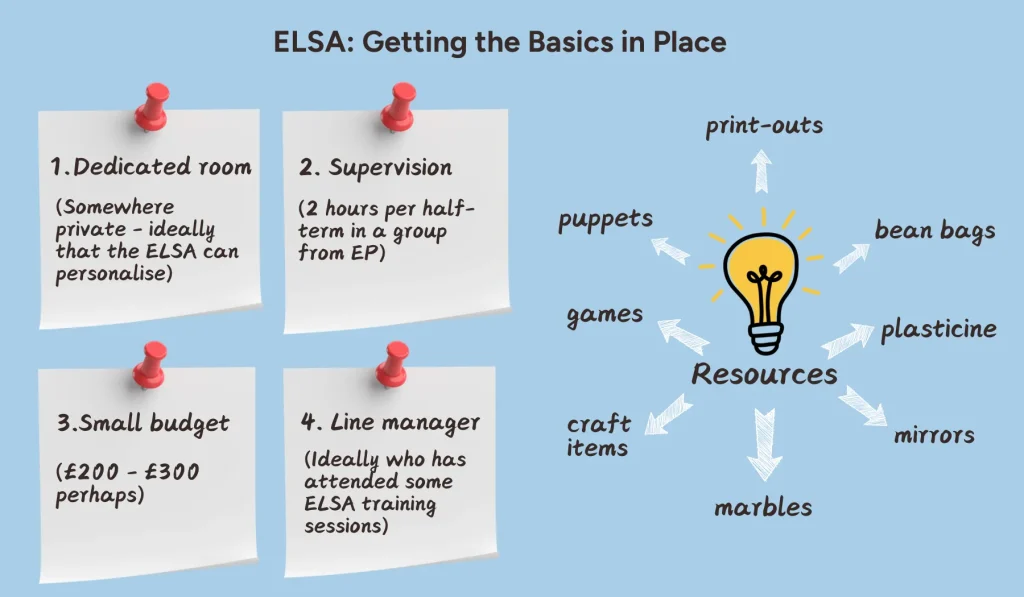
Scrutinise your referral system
Developing a robust referral system hinges on having a detailed mental health provision map in place, matched to your pupil population. This helps the SENCO and Senior Mental Health Lead work out when ELSA intervention will be tried as a first port of call, as opposed to (for example) using Nurture Groups, or the school counsellor.
Ideally, the ELSA needs a clear target to focus on, and inappropriate referrals should be filtered out at either end of the scale, i.e.
- Teachers who refer because a student’s behaviour is difficult to manage in class
- Students who need more specialist/long-lasting support
“There must be a clearly defined element of emotional literacy need,” says Joanna. “You would never dream of implementing a literacy intervention without a consistent referral process and clearly defined target outcomes at the end. ELSA should work in a similar way.”
Creating a simple triage map and formal referral process can contribute to this. “Sometimes ELSAs become so embedded into a school that staff feel there’s no need for formal referral,” warns Joanna, “but it really does help to have a clear system.”
[EXPLORE FURTHER: New to-role Senior Mental Health Leads can learn how to build and enhance the mental health provision map for their setting on our senior mental health lead training courses]
[BECOME AN ELSA: With the Level 5 Specialist Teaching Assistant with ELSA status]

Look out for ELSAs’ own wellbeing
“In reality, as much as we try to avoid it, ELSAs are dealing with all sorts of very challenging things,” Joanna emphasises. “People who work in education often underestimate the weight of the emotional load that can be passed from child to adult” she explains, “this is why supervision is so very important, but it can only go so far.”
Joanna is keen to point out that an experienced line manager is also important – ideally, someone who has also attended some of the training sessions and is familiar with the content. She also suggests scheduling some time when ELSAs within schools can get together to connect, perhaps a fortnightly Friday lunch break before the weekend.
Make sure there is whole-school buy-in
The Senior Mental Health Lead will also want to consider how ELSAs will fit into their setting’s vision and provision for mental health and wellbeing.
Everyone in school should be aware of the aims and objectives of the ELSA programme and how the role fits in with others such as mental health first aiders, the SENCO, the pastoral support team and the DSL.
Recognise that time will need to be allocated not just to running the sessions, but for planning, engaging with supervision, and attending meetings with the mental health team. When it comes to sacrificing lesson time, make sure you communicate this as early as possible to teachers whose lessons will be impacted.
Focus on ELSA retention and development with clear career development
Because trusting one-to-one relationships are at the heart of ELSA, high staff turnover can be a problem. Creating a clearer career pathway for TAs and more professional development opportunities is just one way to address this. The recently approved Level 5 Specialist TA apprenticeship provides such an opportunity.
Real Training’s Educational Psychologists have teamed up with our sister company Educational and Sporting Futures, to offer ELSA status if you choose the social and emotional wellbeing strand of the Level 5 apprenticeship. This will allow you to practise as an ELSA while gaining your Level 5 qualification and (optional) HLTA status with supervision provided for the duration of the course.
Careful timetabling
Potential loss of subject time for ELSA sessions has to be weighed up with the impact of missing activities such as choir or football (which could also benefit the pupil’s mental health). One way to address this is to get creative. “I’ve known ELSAs who get involved in cookery, music or basketball with pupils as a way to help them to connect – it’s all about following the interest of the child and building the relationship,” Joanna says.
Many ELSAs use lunch breaks to try to fit in children as waiting lists can be long. Joanna cautions against this as doing so may mean the pupil misses out on important social activities, as well as putting pressure on the ELSA.
Be clear on targets and measuring wider impact
ELSA work is bespoke, strengths-based and person-centred. Targets are individually constructed with the young person and linked to referral information. “Targets are best thought of as the smallest thing that can make the biggest difference,” says Joanna.
Individual targets could look like the following;
- By Christmas, Adam will be able to identify three triggers that make him feel angry and at least two strategies that help him to control his emotions.
- By the end of May, Sara can include her peers’ ideas in group work at least once a week.
It’s helpful to use some kind of short check-in sheet to keep a record of progress towards targets (see two examples below).
Your school may also want to use more formal assessment methods to measure the overall success of their ELSA programme, such as the Boxhall Profile or the free Goodman’s Strengths and Difficulties Questionnaire (SDQ), as well as looking at things like attendance data.
[DOWNLOAD THE TOOLS: Take a look at the ELSA Check-in: How Are Things?
and this Progress Scoring Matrix, provided by a fellow ELSA trainer with kind permission.]
Think carefully about the appropriateness of group sessions
Although some pupils find group sessions useful for building social confidence and skills, others do not. Qualitative feedback from a recent research study showed that some pupils felt sessions were covering old ground and didn’t always meet their individual needs, while others were uncomfortable with mixed-age sessions.
“Plan group sizes and dynamics carefully,” advises Joanna, “everything must be matched to targets”. It may seem efficient to run group sessions for improving social skills, but in reality, “having a large number of children with limited social aptitude trying to work through the sessions can be unhelpful; the same as it would be for sessions on anxiety.”
Support the safe development of independence
ELSAs follow a regimented timeline to avoid over-dependency. They might incorporate a visual ladder to help show children where they are in the process or a countdown to indicate when sessions are coming to an end.
It’s perfectly natural and normal that contact continues informally after a block of sessions has ended. This can be a real positive for both ELSA and pupil. It may be beneficial to build a quick informal check-in into the follow-up process a few weeks after ELSA sessions have finished, so the child knows they will have an opportunity to share their progress.
How to maximise the impact of ELSAs (mature phase)
Strengthen connections between key adults around the child
It’s important ELSAs have regular (ideally half-termly meetings) with the SENCO and other adults around the child. Session content is confidential but, with the consent of the child, targets and small wins can be shared. Some things may be relevant to record in a pupil passport so knowledge can be easily shared, or communicated to other professionals, such as those leading Nurture Groups, play therapists or art therapists.
Improving communication with parents might be another area for development. In a review by Staffordshire Educational Psychology Service, secondary school ELSAs reported that since the pandemic parents are becoming more anxious about their children’s progress and valued a closer relationship with their TA.
Train a team of ELSAs
It’s always good to have at least two trained ELSAs in a setting but many schools also go on to expand the programme. Aside from extending the service to more young people, a team of ELSAs are also better able to support one another.
Top-up or refresher training
Many ELSAs benefit from deeper training on some elements of the role, for example target setting, neurodiversity, mental health, trauma-informed work, executive function and emotional regulation. Having some sort of CPD also helps the ELSA feel valued in the role.
Strengthen school ethos around core ELSA concepts
For example, attachment and relationship building are key elements in the ELSA intervention, could your school access training about attachment to help cement these principles at a school-wide level?
[EXPLORE OUR COURSES: Attachment theory is covered in our Social and Emotional Mental Health Needs module.]
Extended services such as transition workshops
If ELSAs are willing and capable, you might want to consider running drop-in sessions and ELSA-run workshops for the rest of the school staff on topics like managing transitions.
Create a resource bank and bring ELSAs together to share ideas
“Obviously interventions should be carried out on an individual-by-individual basis” explains Joanna, “but if there are common issues, other ELSAs or previous ELSAs might be able to say; ‘hey this resource worked really well for a similar aged pupil, why don’t you try it?’
Joanna recommends looking at resource hubs such as the one run by ELSA network and ELSA-support or creating your own and encouraging people to leave annotated notes and observations. If there are ELSAs who are particularly confident they might like to do a short video or workshop on how to use the resource that can be used by other TAs or even parents.
If your school is part of a trust it can be helpful to bring ELSAs and pastoral support teams together to share ideas, across Primary and Secondary divisions respectively.
Don’t let fidelity wane over time
“The most common reason that ELSA fails is because the model gets watered down or forgotten about,” Joanna says. “Make sure systems are in place to regularly check that ELSAs are still running distinct blocks of sessions with clear targets and that they are attending regular supervision.”
Conclusion
ELSAs have gained increasing popularity in recent years with many studies showing TAs, parents, children and Headteachers widely reporting a positive impact.
It is important that school leaders make the most of the available resources they have to support children with social and emotional mental health needs. Without being ready to meet this need when it arises, many children avoid school completely or are not in a good place to engage in class. As Dr. James P. Comer, a child psychiatrist and Yale University professor so adeptly puts it, ‘no significant learning occurs without a significant relationship.’
The good news is that more frameworks are now in place to help guide schools in the right direction when it comes to implementing ELSA – as well as new fully funded routes to support TA career progression, including ELSA training.

